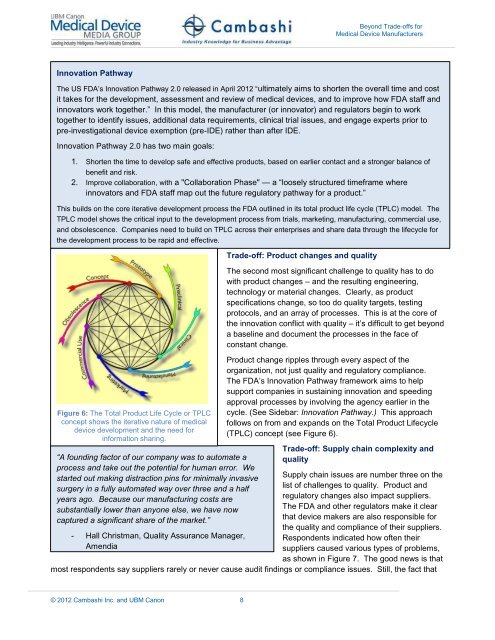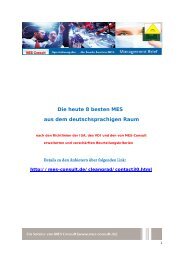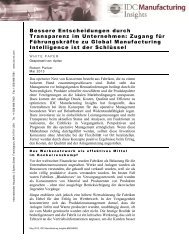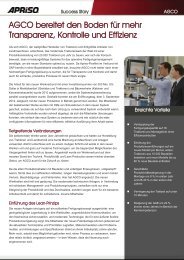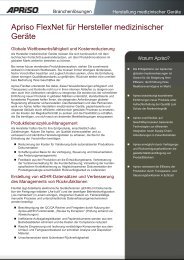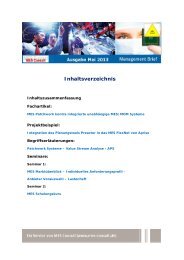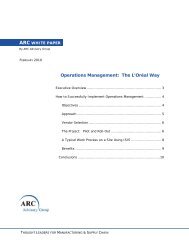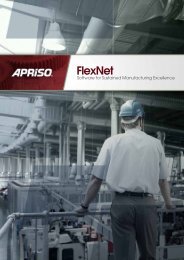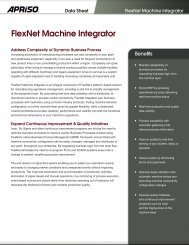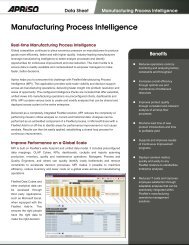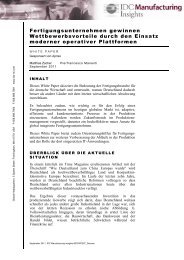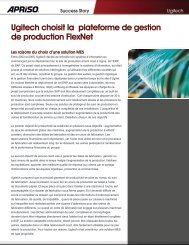Beyond Trade-offs: How Medical Device Manufacturers can ... - Apriso
Beyond Trade-offs: How Medical Device Manufacturers can ... - Apriso
Beyond Trade-offs: How Medical Device Manufacturers can ... - Apriso
Create successful ePaper yourself
Turn your PDF publications into a flip-book with our unique Google optimized e-Paper software.
Innovation Pathway<br />
© 2012 Cambashi Inc. and UBM Canon 8<br />
<strong>Trade</strong>-off: Product changes and quality<br />
<strong>Beyond</strong> <strong>Trade</strong>-<strong>offs</strong> for<br />
<strong>Medical</strong> <strong>Device</strong> <strong>Manufacturers</strong><br />
The US FDA’s Innovation Pathway 2.0 released in April 2012 “ultimately aims to shorten the overall time and cost<br />
it takes for the development, assessment and review of medical devices, and to improve how FDA staff and<br />
innovators work together.” In this model, the manufacturer (or innovator) and regulators begin to work<br />
together to identify issues, additional data requirements, clinical trial issues, and engage experts prior to<br />
pre-investigational device exemption (pre-IDE) rather than after IDE.<br />
Innovation Pathway 2.0 has two main goals:<br />
1. Shorten the time to develop safe and effective products, based on earlier contact and a stronger balance of<br />
benefit and risk.<br />
2. Improve collaboration, with a "Collaboration Phase" — a “loosely structured timeframe where<br />
innovators and FDA staff map out the future regulatory pathway for a product.”<br />
This builds on the core iterative development process the FDA outlined in its total product life cycle (TPLC) model. The<br />
TPLC model shows the critical input to the development process from trials, marketing, manufacturing, commercial use,<br />
and obsolescence. Companies need to build on TPLC across their enterprises and share data through the lifecycle for<br />
the development process to be rapid and effective.<br />
Figure 6: The Total Product Life Cycle or TPLC<br />
concept shows the iterative nature of medical<br />
device development and the need for<br />
information sharing.<br />
“A founding factor of our company was to automate a<br />
process and take out the potential for human error. We<br />
started out making distraction pins for minimally invasive<br />
surgery in a fully automated way over three and a half<br />
years ago. Because our manufacturing costs are<br />
substantially lower than anyone else, we have now<br />
captured a signifi<strong>can</strong>t share of the market.”<br />
- Hall Christman, Quality Assurance Manager,<br />
Amendia<br />
The second most signifi<strong>can</strong>t challenge to quality has to do<br />
with product changes – and the resulting engineering,<br />
technology or material changes. Clearly, as product<br />
specifications change, so too do quality targets, testing<br />
protocols, and an array of processes. This is at the core of<br />
the innovation conflict with quality – it’s difficult to get beyond<br />
a baseline and document the processes in the face of<br />
constant change.<br />
Product change ripples through every aspect of the<br />
organization, not just quality and regulatory compliance.<br />
The FDA’s Innovation Pathway framework aims to help<br />
support companies in sustaining innovation and speeding<br />
approval processes by involving the agency earlier in the<br />
cycle. (See Sidebar: Innovation Pathway.) This approach<br />
follows on from and expands on the Total Product Lifecycle<br />
(TPLC) concept (see Figure 6).<br />
<strong>Trade</strong>-off: Supply chain complexity and<br />
quality<br />
Supply chain issues are number three on the<br />
list of challenges to quality. Product and<br />
regulatory changes also impact suppliers.<br />
The FDA and other regulators make it clear<br />
that device makers are also responsible for<br />
the quality and compliance of their suppliers.<br />
Respondents indicated how often their<br />
suppliers caused various types of problems,<br />
as shown in Figure 7. The good news is that<br />
most respondents say suppliers rarely or never cause audit findings or compliance issues. Still, the fact that


